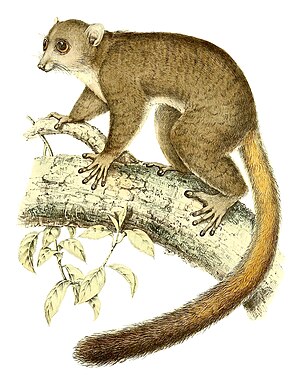Giant mouse lemurs
| Giant mouse lemurs | ||||||||||||
|---|---|---|---|---|---|---|---|---|---|---|---|---|

|
||||||||||||
| Systematics | ||||||||||||
|
||||||||||||
| Scientific name | ||||||||||||
| Mirza | ||||||||||||
| Gray , 1870 |
The giant mouse lemurs ( Mirza ) are a genus of primate from the lemur family of lemurs . It includes two types
- the northern or giant mouse lemur ( Mirza zaza ) and
- the southern or great giant mouse lemur ( Mirza coquereli ).
description
The name giant lemur comes from the fact that the animals were previously classified in the genus of the mouse lemur, but are significantly larger than this. They reach a head body length of 23 to 27 centimeters, the tail measures 26 to 32 centimeters. Their weight varies between 265 and 335 grams. Their fur is gray-brown on the upper side, the underside is light gray. The tail is bushy and darkens towards the tip. The head is rounded, the eyes are large, the ears are hairless. The southern giant mouse lemur is somewhat larger and heavier than its northern relative, it also has larger ears, but a smaller testicle volume.
distribution and habitat
Giant mouse lemurs, like all lemurs, are only found on the island of Madagascar , their distribution area includes the lower-lying dry forests on the west coast of this island, mostly near rivers.
Lifestyle and diet
These primates are nocturnal, they spend the day in self-made nests made of leaves and twigs. At night they go in search of food, mostly moving on all fours through the branches, sometimes they come to the ground. While the southern giant mouse lemur sleeps alone, the northern forms sleeping groups with up to eight animals. At least with the southern representative, the animals establish a range of up to 4 hectares, which are marked with glandular secretions or possibly also with sounds. In contrast to the mouse lemur, they do not hibernate or go into daily paralysis , but their degree of activity is limited in the dry season.
They are omnivores and eat fruits, flowers, buds, tree sap, insects and other small animals. The composition of the food varies depending on the season; fruits are more common, especially in the rainy season. In the dry season, insect excretions can make up up to 60% of the diet. The southern giant mouse lemur is known to sometimes eat small vertebrates.
Reproduction
The reproduction of both species is not uniform. Northern giant lemurs have an earlier mating season (sometimes as early as July to August) and have a promiscuous mating behavior; with the southern giant lemurs, the females are often only receptive for a few hours or days in November and the males establish larger mating territories beforehand.
After a gestation period of around 90 days, the female gives birth to one or two young. These are weaned after four and a half months and can be sexually mature by 10 months. The maximum known age was 15 years.
threat
The destruction of their habitat through slash and burn and deforestation is considered to be the main threat to the giant lemur. The IUCN lists the southern giant mouse lemur as "low endangered"; precise data are missing for the northern giant mouse lemur.
Systematics
Until the 1990s, the giant lemurs were still incorporated into the genus of the mouse lemurs, but they are still considered to be their sister group . It was only in 2005 that researchers at the German Primate Center (DPZ) and the Georg-August University of Göttingen recognized that the northern representative is a species that is separate from the southern giant mouse lemur .
literature
- Nick Garbutt: Mammals of Madagascar. A Complete Guide. Yale University Press, New Haven CT 2007, ISBN 978-0-300-12550-4 .
- Thomas Geissmann : Comparative Primatology. Springer-Verlag, Berlin et al. 2002, ISBN 3-540-43645-6 .
- Russell A. Mittermeier , Jörg U. Ganzhorn, William R. Konstant, Kenneth Glander, Ian Tattersall , Colin P. Groves , Anthony B. Rylands, Andreas Hapke, Jonah Ratsimbazafy, Mireya I. Mayor, Edward Louis jr, Yves Rumpler, Christoph Schwitzer, Rodin Rasoloarison: Lemur Diversity in Madagascar. In: International Journal of Primatology. 29, 2008, ISSN 0164-0291 , pp. 1607-1656.
- Ronald M. Nowak: Walker's Mammals of the World. 6th edition. Johns Hopkins University Press, Baltimore MD 1999, ISBN 0-8018-5789-9 .